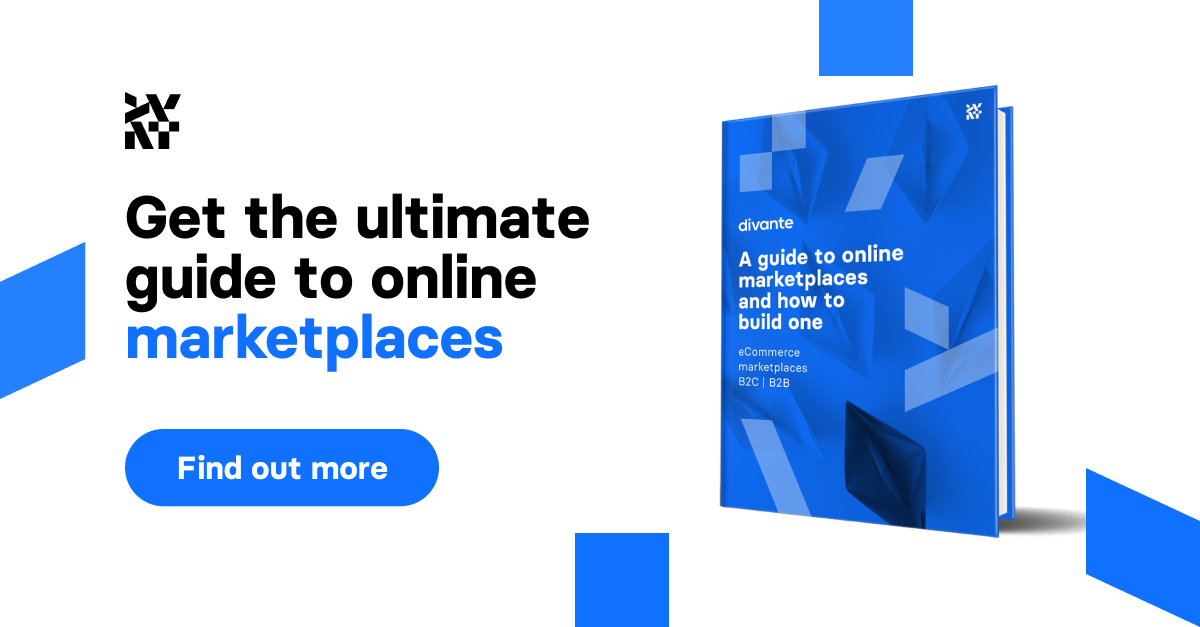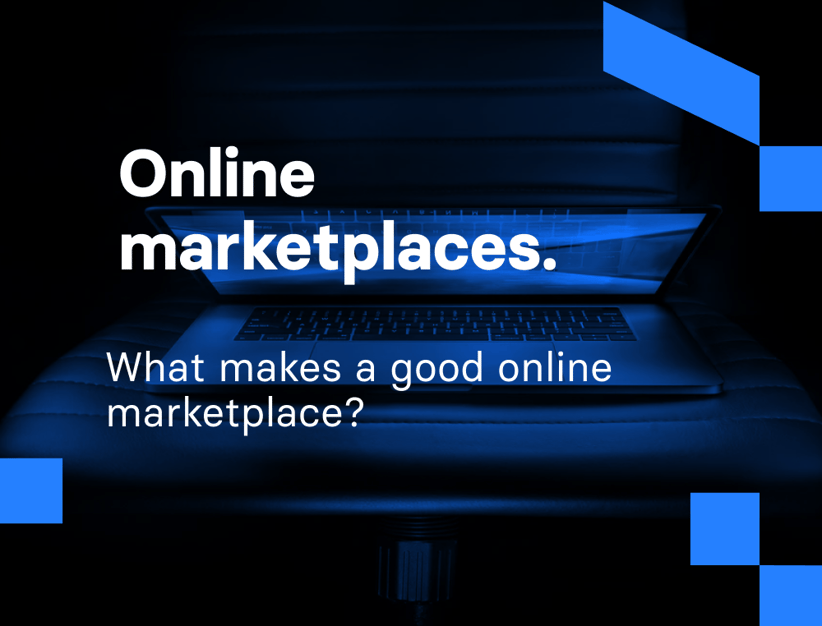Individual online stores may seem like the bread and butter of eCommerce but did you know that more than 50% of online sales are made through marketplaces? They represent massive opportunities for investors, entrepreneurs, and established retailers, both in the B2B and B2C sectors.
In our eCommerce Trends 2020 report, now available to read in full, 22% of respondents from the eCommerce sector said that they had invested in building a marketplace in the last year while ‘Selling and Advertising on Marketplaces’ was highlighted as one of the top 8 trends for positive ROI. We, therefore, placed Marketplaces in our ‘Top 12 Trends for 2020’ list within the Quick Wins category.
This articles is from this series which we have compiled into one handy, downloadable resource. The 50-page ebook is augmented with additional statistics, expert opinions, and other great content. No matter your knowledge entry level, it's the ultimate guide to online marketplaces. Go to: A guide to online marketplaces and how to build one
What is an online marketplace?
An online store is generally an internet shop where one retailer offers its products and services to clients. Marketplaces are wider ecosystems where clients can find a range of different or competing products from a number of third-party vendors, sold at different prices, with varying delivery times, different customer ratings, and so on. Marketplaces are all about giving customers more choice.
Most people know the marketplace model from eBay and Amazon; it is basically a framework in which any company or individual can display products—like the classified ads in a newspaper—and pay a commission to the site owner from each sale. It’s an effective sales method for vendors, as the sites have massive reach, as well as a great business model for the creators of the marketplace as they are not physically involved in most transactions. While you may not be able to replicate Amazon or eBay and build a multi-purpose global marketplace, newer marketplaces can still prosper by focusing on one geolocation or product niche. So, you might build a marketplace for animal medicines in Hungary and invite third-parties to sell on your site and have great success.
“The main reason marketplace businesses scale so well is that you don’t need to have your own inventory to run one. Airbnb does not own any hotel rooms, but it’s already considered one of the biggest companies providing short term accommodation in the world. This is a really attractive proposition: you can build a huge business without having to spend a lot of money to buy the initial inventory, and thus taking on a lot of risk.”
Cristobal Garcia @ Sharetribe
However, online marketplaces are not just the next Zalando, Amazon, or Airbnb; established businesses are moving from online eCommerce to a marketplace model as it allows them to bring third-parties into their sales channels and offer a more complete customer experience. It is easier, quicker, cheaper, and more effective than building the products that those third-parties provide or becoming an expert in their realm. As discussed by Best Buy Canada, who built their marketplace with Mirakl, a Divante partner.
We’re going to look at both of these business templates and discuss what makes a good online marketplace.
The biggest online marketplaces in the world
We’ll let the numbers do the talking. Amazon is approaching 5 billion visits a month and marketplaces are continually increasing in popularity.
| Marketplace | Region | Products | Monthly visitors |
| Amazon | Global | Global | 4.6 B |
| eBay | Global | Global | 1,8 B |
| AliExpress | Global | Global | 865 M |
| Mercado Libre | South America | General | 634 M |
| Rakuten | Global | Global | 385 M |
| Walmart | North America | General | 286 M |
| JD Worldwide | Global | General | 264 M |
| Tmall | East Asia | General | 203 M |
| Shopee | Southeast Asia | General | 195 |
| Allegro | Europe | General | 194 |
Source: https://www.similarweb.com/
“Marketplaces are growing in popularity the world over, in terms of adoption and sales volume. It’s not just Amazon in the US, but eBay in Australia, BOL in the Netherlands, Alibaba in China, and many local operators who are carving out an increasingly significant share of retail spending.”
Kiri Masters, Founder of Bobsled Marketing
What makes a good marketplace?
In our next articles, we’ll be looking at some specific features of marketplaces—such as delivery, returns, and checkouts—as well as how to go about building with a tech team. Today, we’re looking at the five big questions you need to ask and answer before you start building.

5 questions to ask when building a marketplace
1. What is our niche?
Essentially, the question could also be ‘Who are our users?’ If you look at the list of top 20 marketplaces worldwide, 17 sell products in all categories and each of them operates in massive global or regional markets. The chance of taking on the big players is long gone. Even with all the VC backing in the world, no new marketplace will make a dent in Amazon’s business. Therefore, if you are thinking about launching a traditional marketplace, you need to differentiate yourself by going for a smaller customer segment and carving out your niche:
- Build a general-purpose marketplace for one country or even one city
- Sell only one category of products, e.g. pet products, life insurance, golf supplies
- Find something unique, like a marketplace that only uses cryptocurrencies (which were highlighted as a ‘game-changer’ trend in our 2020 Report)
Marketplaces operate the same as any other business in this way. You shouldn’t be too general, as the big players have already taken the majority of the business. However, you shouldn’t be too niche either: you won’t last long with a Bitcoin-only marketplace dedicated to selling golf supplies in Hull!
2. How do we solve the chicken-egg problem?
Once you have a marketplace up and running, the business model can be very profitable. However, all sectors have unique challenges and, when setting up a new marketplace, getting started is the big issue. It’s called the chicken-egg problem. Which comes first: the vendors or the buyers? How do you convince third-party vendors to join your platform when there is no established client base? But how do you get shoppers to browse and buy if nobody is selling on your platform? And, how do you get investors to come in with funds if you have neither?
The answer is to build a fast, usable MVP that doesn’t cost the earth and has just enough features to attract the first vendors. It becomes your proof of concept. You’ll soon get an idea of if your business is attractive from the number of users. You’ll then be able to reinvest profits to create a more robust, feature-rich platform, and attract investors.
Of course, the easiest way around this is if you already have a customer base. The great majority of marketplaces that are build today are created by established retailers who want to offer more choice to customers and introduce new revenue streams by taking a commission from third-party vendors selling on the marketplace.
3. How can we turn first-time browsers into buyers?
User Experience is everything in today’s eCommerce.Sites need to be beautiful and intuitive. We live in a world in which nobody is going to read a ‘how to buy’ page. Users expect to find products in only a couple of clicks and to buy then without obstacles. Remember, every product you offer is available elsewhere and can be found with a 5-second Google search. Your marketplace needs to be faster and more convenient than that!
- The more products you have, the easier it is for users to get lost. You need categories and products to be logically and neatly-ordered
- Make sure you have a search feature that is visible and works fast, preferably with predictive text capabilities
- Ensure that users can purchase and organize delivery from multiple vendors in a single checkout, otherwise your marketplace has no advantage over users shopping in separate stores
- Design your store to look and work equally brilliantly on mobile devices and desktops. 80% of store visits are now mobile and it will soon account for half of your sales
Employ UX experts to design your store but accept that it is always a matter of trial and error. UX and UI can be constantly improved through A/B testing. Building with APIs allows you to create multiple versions of your store, which can be live at the same time, with slightly different elements such as button colors or CTAs. Modern analytics tools then let you test the performance of these competing versions of your store against one another and stick with the one that users like best (meaning, obviously, the one which leads to lower bounce rates and higher conversion). This is an ongoing process. It may seem like an unnecessary expense or something to implement down the line, but it is actually cheaper than you imagine and is something that the best marketplaces implement from the very start to gain a competitive advantage.
“If it can be a test, test it. If we can’t test it, we probably don’t do it.”
Stuart Frisby of Booking.com, the marketplace most famed for A/B testing
4. What technology should we use?
When choosing your technology, the criteria you’ll look for in a marketplace are much the same as for any other online business or digital transformation project:
- Build an MVP as fast as possible
- Make sure that load times are rapid and downtime is minimal
- Protect customer and partner data at all stages
- Move away from monolithic systems so you can easily add and improve features
- Build for mobile and desktop users equally from the very start
A marketplace is a complex system used by perhaps hundreds of third-party partners with catalogs including perhaps millions of product variants. If successful, your marketplace also has to handle hundreds, even thousands, of orders at a time (the record was set by Alibaba in November 2019 at 12,000 orders per second!). Simply put, legacy monolithic architecture is not going to cut it in the long run. You need to be thinking about how to create a headless, microservices architecture which also offers great mobile experiences through a PWA as more users go mobile. However, building all of these features from the start would be both time-consuming and overwhelming for your budget. Most companies usually choose to change their existing eCommerce into a Marketplace with established. compatible platforms like Magento and then slowly iterate and add new features and capabilities after they have created a working and useful PoC.
Read how marketplaces like Amazon, eBay, and Etsy all use microservices architecture: Check out the full article
5. What level of customer service do we need to deliver?
Your marketplace needs to offer the same or better customer service than any other online or brick-and-mortar store. That means that questions need to be answered, returns and refunds need to be easy for customers, and it all has to be done in a timely manner. However, marketplaces face a specific challenge that normal online eCommerce stores do not encounter. End customers are buying from third-party vendors who are responsible for the quality of the goods they deliver (and often for the delivery itself if you are not warehousing third-party products). Therefore, as the marketplace owner, you may have no part in the transaction… but if a customer has a negative experience, they will associate it with your marketplace and tell others.
In order to make sure that you provide the level of service customers expect, there are three things you need to do:
- Be transparent. Make it clear to customers if they are buying directly from you or from a third party, and who is responsible for customer care in each case
- Be available. Make sure that customers have direct access to third-party vendors, so they can answer specific questions, but also have a customer service team that knows as much about all your vendors and products as possible. Nobody should ever call and be told “We don’t know anything about it, they just sell on our site.”
- Keep up standards. Whenever possible, carry out due diligence on vendors and their products before you let them join your marketplace. Make sure that the goods offered are of the same quality as your own products. Let customers rate third-party vendors and then use that information. If a vendor falls below a certain rating, you need to discuss their performance, give them a warning, and remove them from your partners if they don’t improve.
If you are building a marketplace or want to know more, look out for the next article in this series in which we will discuss specific features which you can replicate from leading global marketplaces. You can also contact us at hello@divante.com to discuss your build.
*Unless stated, all stats used in this article can be found in the eCommerce Trends 2020 Report
Editorial team: Tim Clayton, Kaja Grzybowska, Justyna Dzikowska
Technical advice: Marek Borzęcki
Published June 8, 2020












